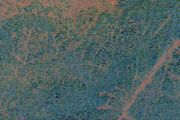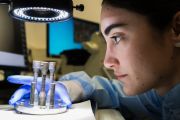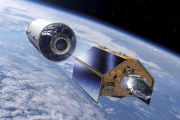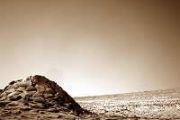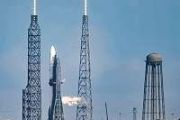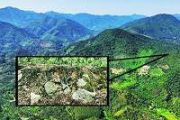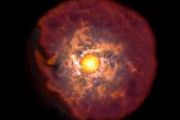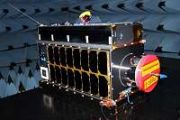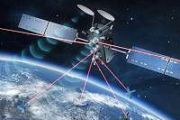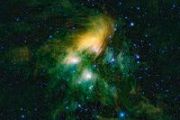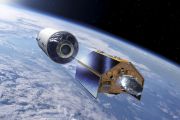
Copernical Team
An interstellar instrument takes a final bow
 They planned to fly for four years and to get as far as Jupiter and Saturn. But nearly half a century and 15 billion miles later, NASA's twin Voyager spacecraft have far exceeded their original mission, winging past the outer planets and busting out of our heliosphere, beyond the influence of the sun. The probes are currently making their way through interstellar space, traveling farther than an
They planned to fly for four years and to get as far as Jupiter and Saturn. But nearly half a century and 15 billion miles later, NASA's twin Voyager spacecraft have far exceeded their original mission, winging past the outer planets and busting out of our heliosphere, beyond the influence of the sun. The probes are currently making their way through interstellar space, traveling farther than an What is the Moon's true origin story
 Over six missions to the moon, from 1969 to 1972, Apollo astronauts collected more than 800 pounds of lunar rock and soil. Chemical and isotopic analysis of that material showed that it was similar to the rock and soil on Earth: calcium-rich, basaltic and dating to about 60 million years after the solar system formed.
Using that data, the planetary scientists who gathered at the Kona Confe
Over six missions to the moon, from 1969 to 1972, Apollo astronauts collected more than 800 pounds of lunar rock and soil. Chemical and isotopic analysis of that material showed that it was similar to the rock and soil on Earth: calcium-rich, basaltic and dating to about 60 million years after the solar system formed.
Using that data, the planetary scientists who gathered at the Kona Confe ESA and Honeywell join forces for ultra-secure data protection with quantum-enabled satellites

In today's complex digital landscape, ensuring secure communications and data protection has become increasingly challenging. Recognising the need to safeguard sensitive information, ESA has partnered with Honeywell UK, a global technology leader in aerospace and digital solutions, to develop quantum satellite technology that could revolutionise data protection for citizens, businesses and governments across Europe and beyond.
NASA's Record-Breaking Laser Demo Completes Mission
 NASA's TBIRD (TeraByte InfraRed Delivery) demonstration and its host spacecraft - the PTD-3 (Pathfinder Technology Demonstrator-3) - have completed their technology demonstration. The TBIRD payload spent the past two years breaking world records for the fastest satellite downlink from space using laser communications.
NASA's PTD series leverages a common commercial spacecraft to provide a
NASA's TBIRD (TeraByte InfraRed Delivery) demonstration and its host spacecraft - the PTD-3 (Pathfinder Technology Demonstrator-3) - have completed their technology demonstration. The TBIRD payload spent the past two years breaking world records for the fastest satellite downlink from space using laser communications.
NASA's PTD series leverages a common commercial spacecraft to provide a Sunken ancient seafloor reveals insights into Earth's interior
 A team of scientists from the University of Maryland has uncovered evidence of a sunken ancient seafloor, dating back to the age of dinosaurs, deep within Earth. This discovery, located at the East Pacific Rise, a tectonic boundary on the southeastern Pacific Ocean floor, challenges existing models of Earth's structure. The findings were published in 'Science Advances' on September 27, 2024.
A team of scientists from the University of Maryland has uncovered evidence of a sunken ancient seafloor, dating back to the age of dinosaurs, deep within Earth. This discovery, located at the East Pacific Rise, a tectonic boundary on the southeastern Pacific Ocean floor, challenges existing models of Earth's structure. The findings were published in 'Science Advances' on September 27, 2024. Solar eclipse to create rare 'ring of fire' over South America
 An annual solar eclipse will create a rare "ring of fire" phenomenon visible in parts of South America on Wednesday.
A "ring of fire" occurs when the Moon lines up between the Sun and the Earth to create a solar eclipse but does not block out the Sun's light entirely.
This year, the Moon will be further from the Earth than usual, so those in parts of Chile and Argentina will be able to w
An annual solar eclipse will create a rare "ring of fire" phenomenon visible in parts of South America on Wednesday.
A "ring of fire" occurs when the Moon lines up between the Sun and the Earth to create a solar eclipse but does not block out the Sun's light entirely.
This year, the Moon will be further from the Earth than usual, so those in parts of Chile and Argentina will be able to w Small exoplanet discovered in 'our cosmic backyard'
 A rare exoplanet smaller than Earth has been discovered orbiting one of the closest stars to the Sun, although its surface is far too hot to sustain life, astronomers said on Tuesday.
The planet orbits Barnard's Star, which is just six light years away, according to observations made over five years by the Very Large Telescope in the Chilean desert.
The astronomers were looking for plan
A rare exoplanet smaller than Earth has been discovered orbiting one of the closest stars to the Sun, although its surface is far too hot to sustain life, astronomers said on Tuesday.
The planet orbits Barnard's Star, which is just six light years away, according to observations made over five years by the Very Large Telescope in the Chilean desert.
The astronomers were looking for plan Webb telescope detects carbon dioxide on Pluto's largest moon
 Scientists using the James Webb Space Telescope have detected carbon dioxide on the frozen surface of Pluto's biggest moon, Charon, for the first time, research revealed on Tuesday.
The discovery of CO2, along with another chemical hydrogen peroxide (H2O2), could shed light on the icy worlds in the mysterious outer reaches of our Solar System.
Pluto was long known as the ninth planet fro
Scientists using the James Webb Space Telescope have detected carbon dioxide on the frozen surface of Pluto's biggest moon, Charon, for the first time, research revealed on Tuesday.
The discovery of CO2, along with another chemical hydrogen peroxide (H2O2), could shed light on the icy worlds in the mysterious outer reaches of our Solar System.
Pluto was long known as the ninth planet fro Uplifting news! ESA crowns new deep space antenna in Australia

This September saw the completion of a critical milestone for the construction of ESA's new deep space communication antenna in New Norcia, Australia: the lifting of the 122-tonne reflector dish.
Dust sparked biggest phytoplankton bloom in decades

New research reveals that dust carried by the wind from southern Africa towards Madagascar triggered the largest phytoplankton bloom in two decades – and, unusually, this occurred at a time of year when such blooms are rarely seen.






